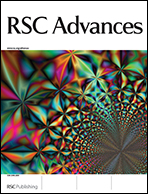Complexation of trivalent lanthanides and actinides with several novel diglycolamide-functionalized calix[4]arenes: solvent extraction, luminescence and theoretical studies†
Abstract
Several diglycolamide-functionalized calix[4]arenes (DGA–Calix) were evaluated for actinide extraction from acidic feeds. The ligands with four diglycolamide (DGA) pendent arms are significantly more effective extractants than those with two DGA pendent arms. The ligands have a preference for the extraction of Eu3+, a representative trivalent lanthanide ion, as compared to Am3+, a commonly encountered trivalent actinide ion. The role of organic diluents on the metal ion extraction was investigated and the results were compared with the widely studied DGA-based extractant TODGA (N,N,N′,N′-tetra-n-octyl diglycolamide). Time resolved laser fluorescence spectroscopy (TRLFS) studies showed a strong complexation with no inner-sphere water molecules in the Eu(III)–DGA–Calix complexes and the complex formation constants (log β) were calculated. Ab initio density functional calculations were carried out to explain the higher stability of the Eu-complex of the DGA–Calix ligand with four pendent arms as compared to the one with two pendent arms.
![Graphical abstract: Complexation of trivalent lanthanides and actinides with several novel diglycolamide-functionalized calix[4]arenes: solvent extraction, luminescence and theoretical studies](/en/Image/Get?imageInfo.ImageType=GA&imageInfo.ImageIdentifier.ManuscriptID=C3RA40241J&imageInfo.ImageIdentifier.Year=2013)

 Please wait while we load your content...
Please wait while we load your content...